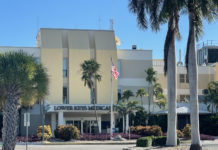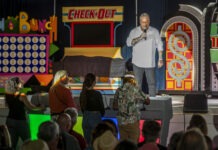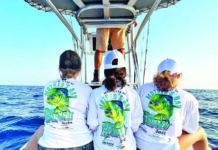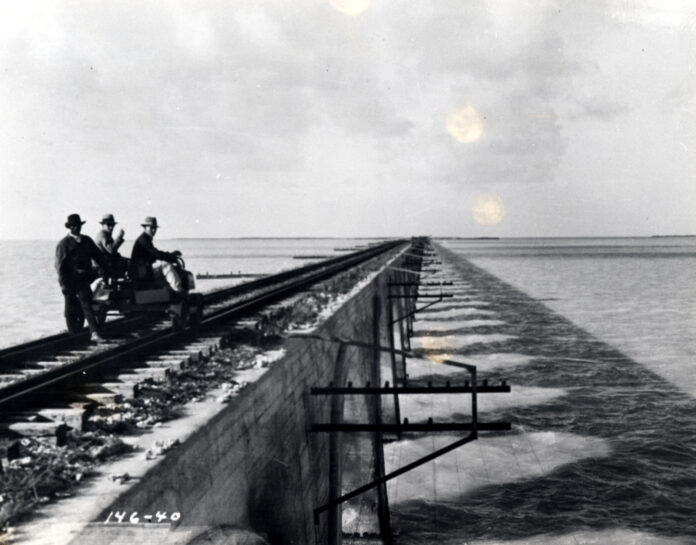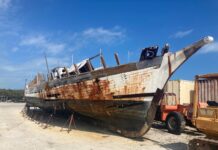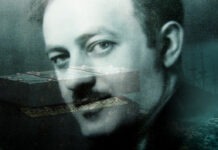The right-of-way for the Key West Extension of Henry Flagler’s Florida East Coast Railway approached the Florida Keys along what is now called the 18-Mile Stretch. It crossed Jewfish Creek and steamed, rocked and rolled down a set of railroad tracks that generally followed what is now the southbound lane of the Overseas Highway and ran to the southernmost terminus at Trumbo Point in Key West.
There were two notable exceptions. After the train traveled past the depots at Rock Harbor, Tavernier, Islamorada, Matecumbe, Long Key and Marathon, the railroad tracks jogged a little to the right of the modern highway. After steaming out of the Marathon Depot, the train rumbled across a series of bridges that crossed Pigeon Key and arrived on Little Duck Key.
The Seven Mile Bridge, both the old and the new, marks, among other things, the transition between the Middle and Lower Keys. In the Lower Keys, the railroad veered away from the modern path of the Overseas Highway in spectacular fashion when it jogged a little to the left at Bahia Honda.
Flagler’s Over-Sea Railroad ran through what is today the entrance to Bahia Honda State Park, followed the park road and passed one of the true treasures of the Florida Keys, a naturally occurring sand beach. In 1992, “Dr. Beach,” Stephen Leatherman declared the mile-long Sandspur Beach the Best Beach in America. The train also roared through the iconic Bahia Honda Bridge before rumbling across the island identified on railroad construction charts as West Summerland Key #1. From the Summerland Keys, the train chugged across Stock Island, entered Key West and rolled into the southernmost terminus at Trumbo Point.
The celebrated arrival of Henry Flagler and his Key West Extension of the Florida East Coast Railway was Jan. 22, 1912. Though Mr. Flagler’s railcar arrived at the southernmost terminus that day, it did not mark the day construction of the railroad was finished.
Because of his failing health, the job of bringing the train to Key West was rushed. Shortcuts were taken to hasten the project and ensure that Flagler saw his dream come to fruition. The railroad engineers were successful, and when Mr. Flagler’s railcar arrived in Key West, it did mark the beginning of daily railroad service operating between railroad depots at Miami and Key West. One of the lesser-reported stories about the railroad is that it was not officially completed until 1916.
Henry Flagler died on May 20, 1912. He never rode down to Key West aboard his private railcar on the completed Over-Sea Railroad project. When Mr. Flagler first made the trip to Key West, the train crossed a series of temporary bridges, including those connecting Lower Matecumbe Key to Long Key. The Channel 2 and Channel 5 bridges were wood trestle bridges during Flagler’s trek. In 1913, the wooden bridges were replaced with concrete viaducts. The Channel 5 Bridge was also fitted with a Bascule drawbridge to enable boats to navigate the channel.
The Long Key Viaduct, the bridge connecting Long Key to Conch Key, was not quite finished in 1912 and still had 1,512 feet of temporary wooden trestles. After Flagler had arrived in Key West, the wooden trestles were replaced with 35 concrete arches. The completed 1.72- mile Long Key Viaduct was the second-longest bridge connecting the mainland to its southernmost terminus at Key West.
In the Lower Keys, the wooden trestle bridges at Little Duck Key, Missouri Key and Ohio Key were replaced by spandrel arch bridges in 1914. The permanent bridge connecting Ohio Key to Bahia Honda was completed in September 1914. The temporary wooden trestle bridge connecting Torch Key to Ramrod Key was replaced with a concrete viaduct bridge in 1915. The wooden trestle bridge crossing Kemp Channel between Summerland Key and Cudjoe Key, too, was replaced with a permanent concrete bridge in March 1915.
The Niles Channel Viaduct was the last of the permanent railroad bridges to be completed. At about a half-mile long, it was the longest of the bridges in the Lower Keys. The bridge was first built with wooden trestles, but by the time Mr. Flagler’s train rocked and rolled across it, the wooden trestles had been replaced with concrete spandrel arches. Work to convert the spandrel arch bridge to a concrete viaduct bridge was completed in November 1915.
The last work conducted on the Key West Extension of the Florida East Coast Railway was completing three miles of causeways between Conch Key and Grassy Key. The project required 2.1 million cubic yards of fill. Two short bridges were also incorporated into the span. The two bridges crossed by Flagler were built of wooden trestles but were replaced with arched concrete bridges in 1913.
Work on the causeways, however, continued, and they were built higher and higher until they reached an elevation of six feet over the pass. The work was not finished until 1916. Its completion marked the final construction project of the Key West Extension of Henry Flagler’s Over-Sea Railroad.
